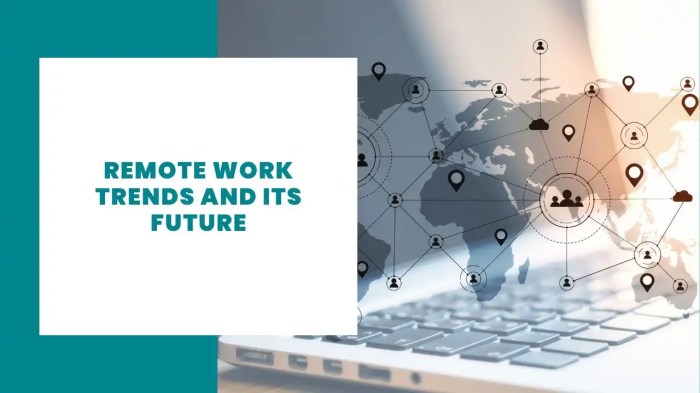Unleashing the Power of Digilife Remote Work Technology
In the realm of modern work culture, Digilife Remote Work Technology stands as a beacon of innovation and efficiency. This technology-driven approach has revolutionized how we work, paving the way for a flexible and dynamic work environment. Let's delve into the intricacies of this transformative trend and explore the endless possibilities it offers.
From enhancing communication to streamlining processes, Digilife Remote Work Technology has truly redefined the way we approach work in the digital age.
Overview of Digilife Remote Work Technology
Digilife Remote Work Technology encompasses a range of digital tools and platforms that enable individuals to work from anywhere, outside of a traditional office setting. These technologies are designed to facilitate communication, collaboration, project management, and productivity in remote work environments.
Examples of Technologies Commonly Used in Remote Work Settings
- Video Conferencing Tools (e.g., Zoom, Microsoft Teams, Google Meet)
- Collaboration Platforms (e.g., Slack, Microsoft Teams, Trello)
- Cloud Storage Services (e.g., Google Drive, Dropbox, OneDrive)
- Project Management Tools (e.g., Asana, Trello, Jira)
- Virtual Private Networks (VPNs) for secure remote access
Impact of Technology on the Remote Work Landscape
Technology has revolutionized the remote work landscape by breaking down geographical barriers and enabling seamless communication and collaboration among remote teams. It has increased flexibility for employees, reduced the need for physical office spaces, and allowed businesses to tap into a global talent pool.
Additionally, remote work technologies have improved efficiency, productivity, and work-life balance for individuals working remotely.
Benefits of Digilife Remote Work Technology

In today's digital age, Digilife Remote Work Technology offers numerous benefits that enhance the remote work experience for individuals and teams alike.
Improved Productivity and Efficiency
Utilizing technology for remote work allows employees to access necessary tools and resources from anywhere, at any time. This accessibility leads to increased productivity as tasks can be completed efficiently without being tied to a physical office space. With the help of project management software, communication tools, and cloud storage solutions, employees can streamline their work processes and stay organized, ultimately boosting their overall efficiency.
Enhanced Collaboration Among Remote Teams
Technology plays a crucial role in fostering collaboration among remote teams by providing various communication channels and collaborative platforms. Through video conferencing, instant messaging, and virtual meeting tools, team members can easily connect, share ideas, and work together seamlessly regardless of their physical locations.
Additionally, cloud-based document sharing and real-time editing features enable remote workers to collaborate on projects in a more efficient and synchronized manner.
Challenges of Implementing Digilife Remote Work Technology
Implementing Digilife Remote Work Technology comes with its own set of challenges that organizations need to address in order to ensure a successful transition. From overcoming technical obstacles to maintaining a healthy work-life balance, here are some common hurdles faced when implementing remote work technology.
Security Concerns and Solutions
One of the major challenges of implementing remote work technology is ensuring the security of company data and sensitive information. With employees accessing company systems from various locations, the risk of data breaches and cyber attacks increases. To address these security concerns, companies often implement robust cybersecurity measures such as encryption, multi-factor authentication, and regular security audits.
Training employees on best practices for data security and providing secure VPN connections are also essential steps in mitigating security risks.
Impact on Work-Life Balance
Another challenge of remote work technology is the potential impact on work-life balance. With the boundaries between work and personal life becoming blurred, employees may find it difficult to switch off from work and disconnect from their devices. This can lead to burnout, decreased productivity, and overall dissatisfaction with work.
To address this issue, companies need to promote a culture of work-life balance by encouraging regular breaks, setting clear expectations around working hours, and providing resources for mental health and well-being support.
Emerging Trends in Digilife Remote Work Technology

As remote work continues to evolve, new technologies are shaping the way we work and collaborate. Let's explore some of the latest trends in Digilife Remote Work Technology.
Role of Artificial Intelligence in Enhancing Remote Work Experiences
Artificial Intelligence (AI) is playing a crucial role in enhancing remote work experiences by automating tasks, improving communication, and increasing productivity. AI-powered tools like chatbots, virtual assistants, and predictive analytics are revolutionizing how remote teams operate.
Innovative Technologies Revolutionizing the Remote Work Landscape
- Virtual Reality (VR) and Augmented Reality (AR) technologies are transforming remote collaboration by creating immersive experiences that simulate in-person interactions.
- Internet of Things (IoT) devices are enabling employees to work remotely while staying connected to their physical work environment through smart devices and sensors.
- Blockchain technology is enhancing security and transparency in remote work environments by providing secure and decentralized data storage solutions.
- 5G technology is revolutionizing remote work by providing faster and more reliable internet connections, enabling seamless video conferencing and real-time collaboration.
Final Summary

As we wrap up our exploration of Digilife Remote Work Technology, it's evident that the fusion of technology and remote work has opened up a new realm of possibilities. Embracing these advancements can lead to heightened productivity, improved collaboration, and a more balanced work-life integration.
The future of work is here, and it's digital.
Essential Questionnaire
How does Digilife Remote Work Technology impact work-life balance?
Digilife Remote Work Technology allows for greater flexibility and autonomy, enabling individuals to create a more harmonious balance between work and personal life.
What are some common technologies used in remote work settings?
Technologies such as video conferencing tools, project management software, and cloud storage solutions are commonly used in remote work environments.
How does technology enhance collaboration among remote teams?
Technology facilitates real-time communication, file sharing, and project tracking, fostering seamless collaboration among remote team members regardless of their physical locations.